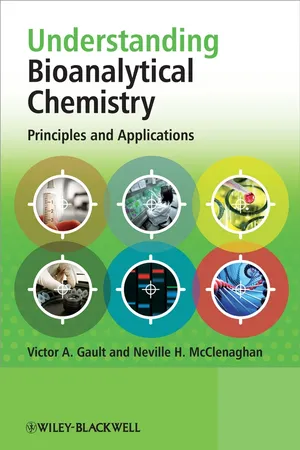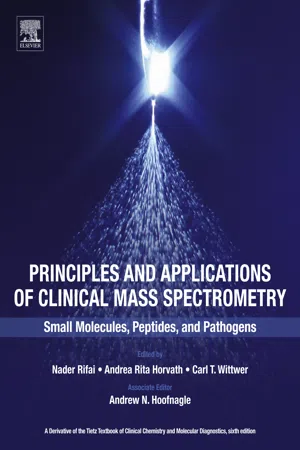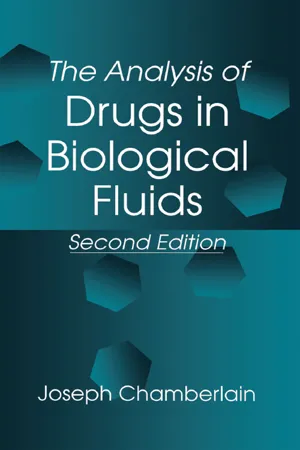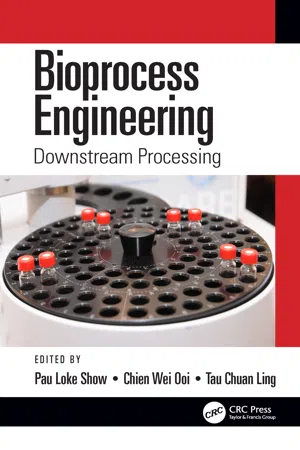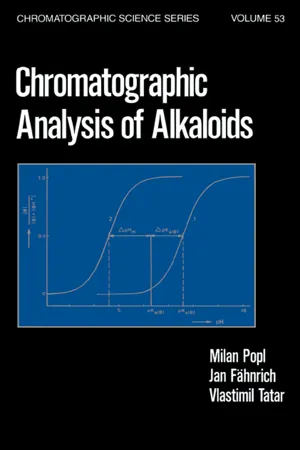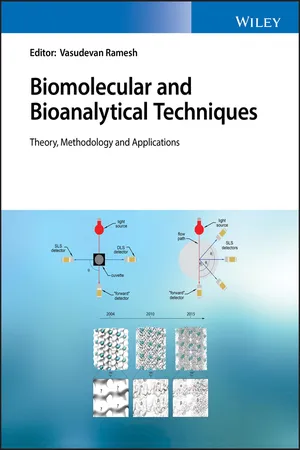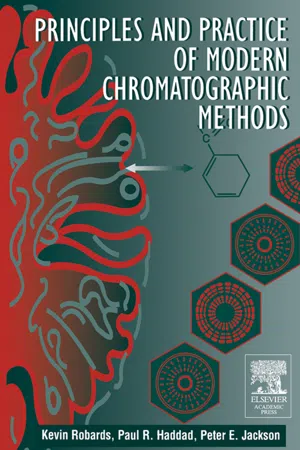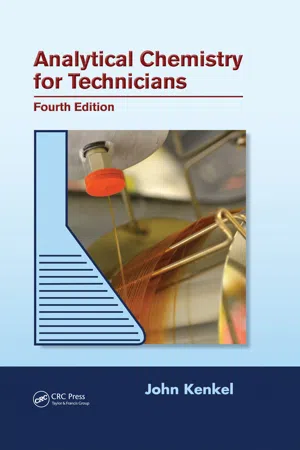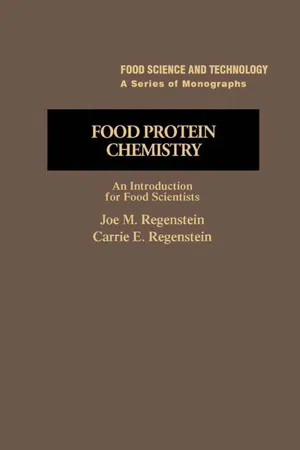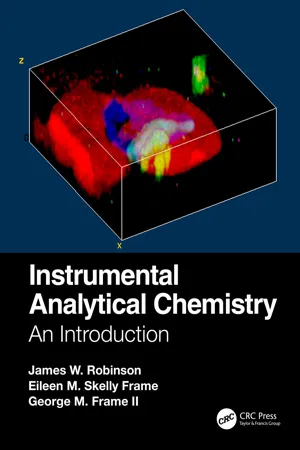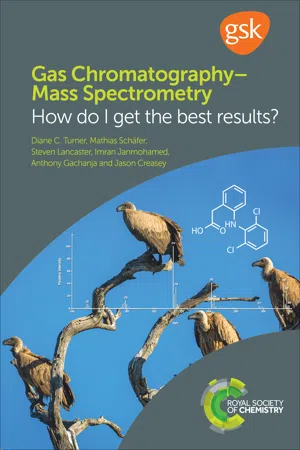Chemistry
Paper Chromatography
Paper chromatography is a technique used to separate and identify different components of a mixture. It involves the use of a stationary phase (paper) and a mobile phase (solvent) to carry the mixture along the paper. As the mixture travels, the components separate based on their affinity for the stationary and mobile phases, allowing for analysis and identification.
Written by Perlego with AI-assistance
Related key terms
Related key terms
1 of 4
Related key terms
1 of 3
12 Key excerpts on "Paper Chromatography"
- eBook - ePub
Understanding Bioanalytical Chemistry
Principles and Applications
- Victor A. Gault, Neville H. McClenaghan(Authors)
- 2013(Publication Date)
- Wiley(Publisher)
Chromatography is the most widely used separation technique in bioanalytical chemistry. There are several different modes of chromatography that are based on different physical and chemical attributes of biomolecules, which include separation based on: ionic charge, solute partitioning, molecular size, and adsorption properties. Subsequent sections provide more information on the different modes of chromatography and their application.The International Union of Pure and Applied Chemistry (IUPAC) define chromatography as a physical method of separation in which the components to be separated are distributed between two distinct phases. The first of these phases is called the stationary phase and the other is called the mobile phase . Basically, in chromatography, a sample containing a mixture of biomolecules is placed onto a stationary phase (which may be either solid or liquid). A mobile phase (which may be either liquid or gas) is then passed through or over the stationary phase, which causes components in the sample to move along the stationary phase. The diverse physical and chemical properties of individual biomolecules within the sample allow components to separate out because they migrate along the stationary phase at different rates. This migration or separation process is referred to as elution , a term you will come across when considering other bioanalytical techniques.There are two major classifications of chromatography according to whether the separation takes place on a planar surface (i.e. flat sheet, e.g. paper or thin-layer chromatography) or in a column (e.g. ion-exchange chromatography). In addition, these can be further sub-divided into liquid chromatography (LC) and gas chromatography (see Table 7.1 ), and the following sections focus on the most popular of the LC techniques.Table 7.1 Basic overview of fundamental chromatography techniques7.2 Principles, types and modes of chromatography
Separation of biomolecules by chromatography relies on different features of the molecule and chromatography system (i.e. stationary and mobile phases). When considering chromatography, two major principles require attention, namely retention and plate theory - eBook - ePub
Principles and Applications of Clinical Mass Spectrometry
Small Molecules, Peptides, and Pathogens
- Nader Rifai, A. Rita Horvath, Carl T. Wittwer, Andy Hoofnagle(Authors)
- 2018(Publication Date)
- Elsevier(Publisher)
1Chromatography
David S. Hage∗Abstract
BackgroundClinical tests often involve the use of one or more separation steps to isolate, enrich, or separate a target compound from other chemicals in the sample. Chromatography is one of the most common methods for achieving this type of separation. In this method, the components of a mixture are separated based on their differential interactions with two chemical or physical phases: a mobile phase and a stationary phase that is held in place by a supporting material. There are many forms of chromatography based on the different mobile phases, stationary phases, and supports that can be used in this method, which has led to a wide range of applications for this technique.ContentThis chapter describes the basic principles of chromatography and discusses various forms of this method that are used for chemical analysis or to prepare specimens for analysis by other techniques. The methods of gas chromatography and liquid chromatography are discussed, as well as the techniques of planar chromatography, supercritical fluid chromatography, and multidimensional separations. The mobile phases, stationary phases, and supports that are used in each of these methods are described. The instrumentation and detection schemes that are employed in these methods are also discussed.Biological fluids are complex mixtures of chemicals. This means that clinical tests for specific components in these fluids often involve the use of one or more separation steps to isolate, enrich, or separate the target compound of interest from other chemicals in the sample. Chromatography is one of the most common methods for achieving this type of separation. This chapter describes the basic principles of chromatography and discusses various forms of this method that are used for chemical analysis or to prepare specimens for analysis by other techniques. - eBook - ePub
- Joseph Chamberlain(Author)
- 2018(Publication Date)
- CRC Press(Publisher)
5 Planar Chromatography CONTENTS 5.1 General Introduction 5.2 Paper Chromatography 5.3 Thin Layer Chromatography 5.3.1 Introduction 5.3.2 New Developments 5.3.2.1 Increasing Resolution 5.3.2.2 Chiral TLC 5.3.2.3 Overpressured Layer Chromatography 5.3.2.4 Rotation Planar Chromatography 5.3.3 Applications 5.3.3.1 Qualitative Screening 5.3.3.2 Metabolism Studies 5.3.3.3 Quantitative Analysis 5.1 GENERAL INTRODUCTIONChromatography is the common laboratory method for both quantitative and qualitative analysis of drugs, particularly new investigational drugs, in biological fluids. This is because chromatographic methods can combine a powerful separation step with a sensitive and specific detection system. This chapter will review the basic principles of chromatography and its original development to what is now called planar chromatography. Subsequent chapters will describe, in more detail, the various aspects of the different types of chromatography that the analyst has at his disposal, explaining the advantages of each type in the modern analytical laboratory.The basic principle underlying all types of chromatography is that the system consists of two components, one stationary and one mobile. This can be exemplified by the original system by Tswett, who described the chromatography of colored pigments extracted from plants. The stationary phase consisted of calcium carbonate packed into a glass column. The extract was placed at the top of the column and washed through with an organic solvent. The components to be separated would be absorbed on the calcium carbonate and dissolved in the organic solvent. The rate at which the individual components (the different pigments) move down the column depends on the relative affinity of the component for the two phases (i.e., stationary and mobile), and it is this relative property which effects the required separation. Tswett’s original papers were in Russian and were published in 1906; an excellent review of his early work in chromatography has been written by Ettre.387 - eBook - ePub
Bioprocess Engineering
Downstream Processing
- Pau Loke Show, Chien Wei Ooi, Tau Chuan Ling, Pau Loke Show, Chien Wei Ooi, Tau Chuan Ling(Authors)
- 2019(Publication Date)
- CRC Press(Publisher)
6 Chromatography Kirupa Sankar Muthuvelu andSenthil Kumar Arumugasamy 6.1 INTRODUCTIONMolecules are produced through a series of reactions that take place in a biological system or in synthetic chemistry. These molecules are recovered in addition to minute quantities of unwanted compounds referred as impurities. The target molecules must be isolated from the impurities for further applications (Pavia, 2005). This can be done on the basis of distinct physical properties such as molecular weight, boiling point, freezing point, crystallization, solubility, density, and chemical properties such as functional group and reactivity.Chromatography consists a group of analytical protocols used for separating mixtures into their individual components (Walls et al., 2011). Before the identification of an unknown compound, it must be resolved to its constituents using a separation method. Since its invention, chromatography has been an important tool for qualitative and quantitative estimation of components present in a mixture.6.1.1 HISTORY OF CHROMATOGRAPHYThe development of chromatography started in the mid-1800s with the work of a German dye chemist, F. F. Runge. Filter paper and water were used to separate the dye components (Ettre and Sakodynskii, 1993). Two reasons are responsible for the separation: the binding capacity of dye components toward the filter paper and also variations in the molecular weight among the dyes. In the 1860s, C. F. Schonbein and his student studied the rate of migration of various substances through filter paper (Ettre, 2000). Schonbein predicted that the separation was due to capillary action and named the technique capillary analysis. In 1906, a Russian botanist, Mikhail Tswett segregated six pigments present in plants, for example, chlorophyll (green) and carotenoids (yellow and orange), through a column loaded with calcium carbonate (CaCO3 ) using petroleum ether as a solvent (Telepchak et al., 2004). Initially, chromatography was to be used only to separate the color components, which is the reason behind its name. The term chromatography was coined from the Greek words Khroma - eBook - ePub
- Milan Popl, Jan Fahnrich, Vlastimil Tatar(Authors)
- 2018(Publication Date)
- Routledge(Publisher)
3 ChromatographyPeople working with chromatography have yet to devise an appropriate and comprehensive definition of this method. Unfortunately, chromatography involves so many specific forms and procedures that no definition comes close. Therefore let us not belabor definition and emphasize instead the ability of chromatography to separate complex mixtures into discrete bands. Chromatography is, before anything else, a separation method, although for the absolute definition of separated components, it must be linked to other analytical methods, mostly spectroscopic.I. PRINCIPLES, CLASSIFICATION, AND NOMENCLATURE A. PrinciplesChromatography in principle is based on the equilibrium distribution of a sample between two phases. The phases are composed of compounds other than the sample components. The volumes of both phases are much larger than that of sample and therefore the distribution coefficients of individual substances remain essentially constant. The separation of a sample by chromatography is achieved by the distribution of substances between mobile and stationary phases. The substances which are held strongly in the mobile phase pass through the system more rapidly than those held strongly in the stationary phase. Thus, the velocity of a component’s movement through the system will depend on intermolecular forces holding the substance in the stationary phase or, more exactly, on the difference of forces between the solute molecules and the molecules of each phase. Because these forces for individual components are different, various substances will travel with different velocity, and in this way, they will be separated.B. ClassificationChromatographic methods may be classified according to (a) type of mobile phase with the subdivision due to stationary phase used, (b) method of sample movement through the bed, and (c) technique. The classification which would be based on the nature of intermolecular forces is not fully accepted because generally two or more kinds of forces are operating simultaneously. - eBook - ePub
Biomolecular and Bioanalytical Techniques
Theory, Methodology and Applications
- Vasudevan Ramesh, Vasudevan Ramesh(Authors)
- 2019(Publication Date)
- Wiley(Publisher)
7 Chromatography: Separation Techniques in BiologyW John Lough and Mark CarlileSchool of Pharmacy and Pharmaceutical Sciences, University of Sunderland, Chester Road, Sunderland, SR1 3SD, UK7.1 Introduction to Chromatographic Separation
Chromatography is a term that is used to describe a group of separation techniques that utilise the distribution of molecules between a stationary phase and a mobile phase [1] . Separation is achieved by exploitation of a molecule's physicochemical properties that promote it to interact with the stationary phase or stay within the mobile phase. Interactions with the stationary phase promote a slower passage through the separation system. It is this distribution and the modulation of the distribution between these phases that makes chromatography a very powerful and versatile separation technique. Different types of molecule have different distribution constants and hence come off the column at different times. Thus, they are separated from one another before being measured. Importantly, this means that quantitative determinations based on chromatography can be optimised to give good specificity. In an analytical method validation to demonstrate that an analytical method is fit for its intended purpose, accuracy, precision, linearity, limit of quantitation and limit of detection may be evaluated, but it is the test for specificity that is often the most challenging of the validation tests [2] . Therein lies perhaps the main reason for the very widespread use of chromatography in biology.The field of ‘biology’ is vast and complex. Within this there are a large and very diverse number of applications for which the power of chromatography may be effectively exploited. Consequently, the entire range of manifestations of ‘chromatography’ can find some use in biology. However, especially in the purification and analysis of intact, large biological molecules, liquid column chromatography (Figure 7.1 ) is by far the most common form of chromatographic separation used [3 ,4 ]. However, the application of gas‐phase chromatographic separation is also becoming more common, especially for the analysis and profiling of cellular metabolism [5] - eBook - ePub
- Kelly M. Elkins(Author)
- 2018(Publication Date)
- CRC Press(Publisher)
October 16, 2011, USA Today. https://usatoday30.usatoday.com/sports/college/mensbasketball/2011-10-16-1691565843_x.htm (accessed January 27, 2018). Chromatography is a technique used to separate components of a mixture by their physical properties including polarity, boiling point, solubility, size, charge, and structure. In chromatography, there are two phases: the mobile and the stationary phase. Mixture components are separated by exploiting the differences in their strengths of interaction with the two phases such as adsorption or binding to the stationary phase and solubility or gas state in the mobile phase. There are several types of chromatography including paper and thin-layer chromatography (TLC) that are named for their stationary phases. Other types, including gas chromatography (GC) and high-performance liquid chromatography (HPLC), have names that reflect their mobile phases. Thin layer, paper, column, and liquid chromatography are all types of liquid chromatography. Column chromatography methods include GC, gravity column chromatography, fast protein liquid chromatography (FPLC), HPLC, and ultra-performance liquid chromatography (UPLC). Thin-layer chromatography TLC is a simple and inexpensive method for separating sample mixtures. TLC typically employs silica [SiO 2 ] n or alumina (Al 2 O 3) as the stationary phase. A thin veneer of the silica or alumina is spread on glass or plastic plates (inert supports) that can be cut to the desired size and dimensions. The stationary phase is more polar than the mobile phase. Silica is used in the separation of polar compounds and the alumina is used to separate less polar or nonpolar compounds. The mobile phase is an organic solvent or mixture of organic solvents in desired proportions. The mobile phase (approximately half a centimeter) is added to a beaker, jar, or other developing chamber that is covered with a glass lid or watch glass - Kevin Robards, P. E. Jackson, Paul A. Haddad(Authors)
- 2012(Publication Date)
- Academic Press(Publisher)
After the mobile phase front has migrated the necessary distance, the chromatogram is removed from the tank and dried. The point which the mobile phase reaches when it flows up the plate is called the solvent front. The separated components are located and characterized by the R f value (see Chapter 2). Planar chromatography is commonly regarded as a qualitative technique. However, almost from its inception, the possibility of using planar techniques for quantitative analysis was recognized. Indeed, Kirchner et al. [ 2 ] described quantitative TLC for the determination of biphenyl in citrus fruits and products as early as 1954. Techniques for quantifying thin layer chromatographic data are now highly refined. 4.1.1 Paper Chromatography The original separations by PC were performed on ordinary filter papers but now special papers are available. These papers are prepared from specially purified cellulose (98–99% α-cellulose, 0.3–1.0% β-cellulose, 0.4–0.8% pentosans and <0.01% mineral ash). They provide a highly purified and reproducible surface with respect to porosity, thickness and arrangement of cellulose fibres. Chromatography papers are characterized by their thickness, weight per unit area and flow-rate index. On this basis, papers may be classified as slow, standard or fast grades corresponding to the degree of coarseness of the cellulose fibres and their packing density. Standard papers represent the best compromise between resolution and the time required to develop the chromatogram. Whatman No. 1 paper or its equivalent is suitable for most separations. Paper has a slight grain, known as the machine direction, and separations may differ according to whether they are made parallel to, or perpendicular to, this grain- eBook - ePub
- John Kenkel(Author)
- 2013(Publication Date)
- CRC Press(Publisher)
10 Introduction to Chromatography10.1 IntroductIon
Modern-day chemical analysis can involve very complicated material samples—complicated in the sense that there can be many substances present in the sample, creating a myriad of problems with interferences when the laboratory worker attempts the analysis. These interferences can manifest themselves in a number of ways. The kind of interference that is most familiar is one in which substances other than the analyte generate an instrumental readout similar to the analyte, such that the interference adds to the readout of the analyte, creating an error. However, an interference can also suppress the readout for the analyte (e.g., by reacting with the analyte). An interference present in a chemical to be used as a standard (such as a primary standard) would cause an error, unless its presence and concentration were known. Analytical chemists must deal with these problems, and chemical procedures designed to effect separations are now commonplace.This chapter, and also Chapters 11 and 12 , describe modern analytical separation science.10.2 Chromatography
A myriad of techniques used to separate complex samples come under the general heading of “chromatography.” The nature of chromatography allows much versatility, speed and applicability particularly when the modern instrumental techniques of gas chromatography (GC) and high-performance liquid chromatography (HPLC) are considered. These latter techniques are covered in detail in Chapters 11 and 12 . In this chapter, we introduce the general concepts of chromatography and give a perspective on its scope. Since there are many different classifications, this will include an organizational scheme covering the different types and configurations that exist.Chromatography is the separation of the components of a mixture based on the different degrees to which they interact with two separate material phases. The nature of the two phases and the kind of interaction can be varied, and this gives rise to the different “types” of chromatography, which will be described in the next section. One of the two phases is a moving phase (the “mobile” phase), whereas the other does not move (the “stationary” phase) (see Figure 10.1 ). The mixture to be separated is usually introduced into the mobile phase, which then is made to move or percolate through the stationary phase either by gravity or some other force. The components of the mixture are attracted to and slowed by the stationary phase to varying degrees, and as a result, they move along with the mobile phase at varying rates, and are thus separated. Figure 10.2 - eBook - ePub
Food Protein Chemistry
An Introduction for Food Scientists
- Joe Regenstein(Author)
- 2012(Publication Date)
- Academic Press(Publisher)
Chapter 15Column Chromatography
Publisher Summary
Column chromatography is used to separate proteins during preparation. It can also be used to analyze or characterize different materials and/or reactions, and it can be used to study the kinetics of an enzyme reaction. This chapter discusses various techniques and types of columns for column chromatography. Partition chromatography is used to obtain a continuous series of separatory funnels. Thin-layer chromatography and Paper Chromatography use the same partition principle to separate materials but on a continuous basis. Paper Chromatography can be done in either an ascending or descending mode. Ion exchange chromatography uses the preferential binding of various positive ions to a particular negative ion bound to the column (or vice versa) to yield the separation of material. Adsorption chromatography utilizes the force of attraction of protein to the column support material. It may result from hydrophobic interaction and/or van der Waals interaction. Molecular exclusion chromatography, also called gel filtration or molecular sieve chromatography is often referred to by the trade name of the most commonly used support material, Sephadex. An adaptation of affinity chromatography is the use of immobilized enzymes.Column chromatography is generally used to separate proteins during a preparation. However, it can also be used to analyze or characterize different materials and/or reactions, and it can even be used to study the kinetics of an enzyme reaction. Clearly, then, this is a broad and important topic of study.Let us start our conceptual introduction with the basic question of how to interpret data presented in the form of peaks. We have already seen this format in the amino acid analysis, and we will have to deal with the problems inherent in this form of presentation in many of the standard techniques. Our greatest specific problem is that in “real life” we rarely get perfect separations on columns. - eBook - ePub
Instrumental Analytical Chemistry
An Introduction
- James W. Robinson, Eileen M. Skelly Frame, George M. Frame II(Authors)
- 2021(Publication Date)
- CRC Press(Publisher)
Principles of Chromatography 10DOI: 10.1201/b21879-1010.1 Introduction to Chromatography
Many of the techniques of spectroscopy we have discussed in preceding chapters are selective for certain atoms or functional groups and structural elements of molecules. Often this selectivity is insufficient to distinguish compounds of closely related structure from each other. It may be insufficient for measurement of low levels of a compound in a mixture of others which produce an interfering spectral signal. Conversely, when we wish to measure the presence and amounts of a large number of different compounds in a mixture, even the availability of unique spectral signatures for each analyte may require laborious repeated measurements with different spectral techniques to characterize the mixture fully. Living systems have evolved large protein molecules (e.g., receptors, enzymes, immune system antibodies) with unique 3D structures which can bind strongly only to very specific organic compounds. Analytical procedures such as immunoassay, enzyme mediated assays, and competitive binding assays, employ the extreme selectivity of such protein macromolecules to measure particular biomolecules in very complex mixtures. Microarrays of thousands of these, each with unique selectivity, can rapidly screen complex mixtures for a list of expected components. However, precise quantitation of each detected component is difficult to achieve this way.Analysis of complex mixtures often requires separation and isolation of components, or classes of components. Examples in non-instrumental analysis include extraction, precipitation, and distillation. These procedures partition components between two phases based on differences in the components' physical properties. In liquid-liquid extraction, components are distributed between two immiscible liquids based on their similarity in polarity to the two liquids (i.e., “like dissolves like”). In precipitation, the separation between solid and liquid phases depends on relative solubility in the liquid phase. In distillation, the partition between the mixture liquid phase and its vapor (prior to recondensation of the separated vapor) is primarily governed by the relative vapor pressures of the components at different temperatures (i.e., differences in boiling points). When the relevant physical properties of the two components are very similar, their distribution between the phases at equilibrium will result in slight enrichment of each in one of the phases, rather than complete separation. To attain nearly complete separation the partition process must be repeated multiple times, and the partially separated fractions recombined and repartitioned multiple times in a carefully organized fashion. This is achieved in the laborious batch processes of countercurrent liquid–liquid extraction, fractional crystallization, and fractional distillation. - eBook - ePub
Gas ChromatographyMass Spectrometry
How Do I Get the Best Results?
- Diane C Turner, Mathias Schäfer, Steven Lancaster, Imran Janmohamed, Anthony Gachanja, Jason Creasey(Authors)
- 2019(Publication Date)
- Royal Society of Chemistry(Publisher)
According to the International Union of Pure and Applied Chemistry (IUPAC), chromatography is defined as a separation process that is achieved by distributing the components of a mixture between two phases, a stationary and a mobile phase. Gas chromatography involves a sample being separated into its component parts by equilibration between the carrier gas (usually helium for GC-MS applications, however nitrogen, hydrogen and argon/methane mixtures are used for many GC applications) and a stationary phase. A component which has a large affinity for the stationary phase will take longer to travel through the column than a component which has a low affinity for the stationary phase. As a result of this, sample components will become separated from each other as they travel along the column. This process is called elution. The processes giving rise to retention are statistical in nature and the rate at which an analyte moves through the column is determined by the average time it spends in the mobile phase. In the best performing systems, the peaks are Gaussian because of the statistical nature of the separation processes.Therefore, solutes are eluted from the system as local concentrations in the carrier gas in the order of their increasing distribution coefficients with respect to the stationary phase; and ipso facto , separation is achieved.Chromatographic methods can be broadly classified in terms of the mobile phase, therefore we have gas chromatography, liquid chromatography, and supercritical fluid chromatography as well as the kind of equilibria involved in the transfer of solutes between the phases for example partition, adsorption, size exclusion, ion exclusion and ion exchange. This chapter will concentrate on the separations that can be achieved using gas chromatography.In gas chromatography, the mobile phase is always a gas, note that it is not a phase in the true thermodynamic sense, in that there should be no thermodynamic interactions between the carrier gas and the analyte, unlike the mobile phase in liquid chromatography which solvates the analyte. However the stationary phase can be a solid, a liquid adsorbed onto a solid or an organic species bonded to a solid surface. In gas–solid chromatography (GSC) the solid sorbent is packed into a column, similar to an HPLC column, or affixed to the inner walls of a capillary column as a porous layer open tube (PLOT) column. In GSC, separation is based upon the non-linear adsorption of gaseous substances onto solid surfaces and therefore these columns are used for small gaseous species and volatile hydrocarbons using GC, but not GC-MS instrumentation.The most common type of gas chromatography, used to separate volatile organic compounds (VOCs), is gas–liquid chromatography (GLC). In GLC, separation is achieved through partitioning of the analytes between the mobile phase and the stationary phase, which is a viscous liquid coated onto the inside of a very narrow tube. This configuration is known as a wall coated open tube (WCOT). The tube itself is a long narrow length of deactivated fused silica, coated on the outside with polyimide to protect the silica and to make it flexible, with internal diameters commonly ranging from 0.1–0.53 mm and lengths that are usually between 10–150 m. The most common dimensions are a 0.25 mm internal diameter and a length of 30 m, enabling fast separations with a good efficiency, peak shapes and sensitivity. GC-MS instruments use WCOT, commonly known as capillary columns and therefore this chapter will focus on these columns, which separate analytes using partitioning.
Index pages curate the most relevant extracts from our library of academic textbooks. They’ve been created using an in-house natural language model (NLM), each adding context and meaning to key research topics.
Explore more topic indexes
Explore more topic indexes
1 of 6
Explore more topic indexes
1 of 4
